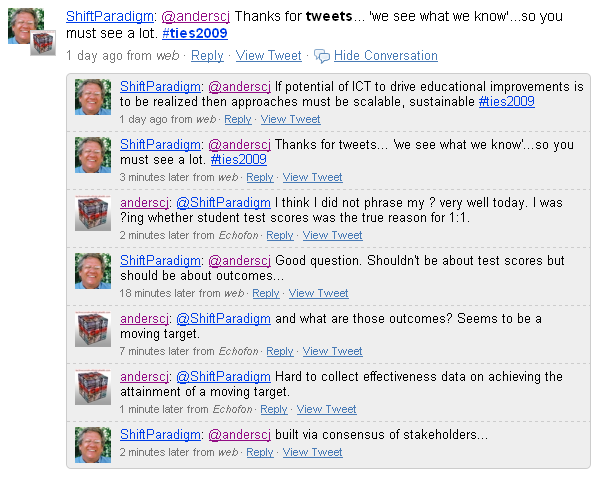While this year's TIES Conference had one of the most impressive, valuable, and thought provoking lineups of any conference I have attended in recent memory, perhaps the most interesting thing was not on stage or formally part of any particular session. For me the most interesting aspect of this conference was what was happening on Twitter. Many of us used Twitter this year to take notes and share resources related to sessions. This allowed six powerful things to occur that were not as effortless in the past. I thought it would be worth some time today to identify these six things and reflect on their impact.
Five Things Twitter Made Possible at #ties2009:
1. Networking
2. Sharing Resources
3. Reflective Practice
4. Amplification
5. Outside Influence
6. Extra Innings
Networking:
Networking is a huge reason people in any field attend a conference. It is important from time to time to convene with colleagues from other places to share ideas, gain contacts, and establish relationships. It can even be argued that in the information age this is the only meaningful reason to justify the cost of attend a conference. Before Twitter I would go to a conference and only establish meaningful relationships with a hand full of people and the majority of those people just became another card in my Rolodex. Following the #ties2009 Twitter stream people were able to find other people to connect with with similar affinities. When meeting these new people in person many times we had already been engaged in a conversation so the time from hand shake to meaningful dialog was greatly reduced. Twitter also provides an integrated ability to contact other people, so if you make the connection there you already have an instant connection to that person. Goodbye Rolodex, hello Twitter follow stream.
Sharing Resources
One of the most concrete applications of this tool is as a platform for sharing resources. During keynote speeches and sessions participants often shared links to related content online. This is essentially a Google Jockey technique applied to a backchannel. These resources could either be set aside for reference after the session or brought up to add value to session goers experience.
Reflective Practice
Twitter facilitated many instances of reflective practice during and after sessions. It allowed attendees to re-contextualize ideas, pose questions to the group, and discuss topics.
Amplification
Each Twitter user has their followers, their followers have their own followers, and the web of relationships spreads out from there. Having our conversations on Twitter allowed the conference to be amplified beyond the Hyatt Regency in Minneapolis to a global audience. Tweeted notes from the sessions reached people both in regionally and globally who could not attend in person. It undoubtedly brought awareness of the conference to a broader audience. The thoughts and content of the sessions reached a much larger audience and will likely have a greater impact than if the message were only heard by those in attendance.
Outside Influence
Tweeting notes from sessions allowed people not attending the conference to follow what was going on and what was being said in real time. Essentially this allowed conference Tweeters to become proxies or conduits for those not in attendance. These proxies could ask questions posed by the network. These outside voices also could also make attendees aware of additional or contradictory views other than those presented in the sessions.
Extra Innings
Because the #ties2009 hash tag will outlast the conference indefinitely the conference has the potential to live on indefinitely in this space. For as long the TIES Conference Twitter users are engaged in conference discussion the conference can live on. This has enormous power especially for teachers otherwise relatively isolated either by geography or by school culture. The conference lasts only four days (if you include the weekend workshops) but the conversations regarding the conference could go on forever.

Additionally, each conference session is only so long and often session-goers are left with questions for the presenter or each other that time does not permit. For those of us connected, Twitter allowed for those questions to be answered and the conversation to continue well past the hour set aside for the presenter's session.



















5 comments:
Wow - thanks for this thoughtful post! I appreciate your taking the time to break this down and reflect on this aspect of the conference. I thought the "Twitter dimension" was a powerful, ad-hoc tool for documenting the conference. TIES will be digesting this for next year's conference! (@ccaswell)
I echo Chad's comments. Great reflection. For those of us early adopters (relatively) of Twitter, it is encouraging that people are utilizing it in the ways you mentioned. I remember 2 years ago, suggesting a hashtag, and people looking at me funny! If it's taken 2 years for the "techy" people to see the value, how long before the average teacher is using it as effectively?
Just today I had about 10 staff members asking me to help them get on Twitter. The time to adoption might not be that big. I suspect we will always have those who choose not to engage though. That is probably alright. After all, we all learn differently.
Carl, good job summarizing the new experiences from the conference. I'm looking forward to continue my learning through the posts - I'm still reflecting on all the information that was shared. Live long #ties2009!
These would be the same reasons we would want students using Twitter. Instead, most district block Twitter, even for high school students.
Post a Comment